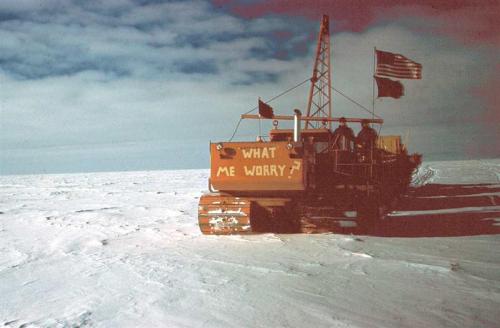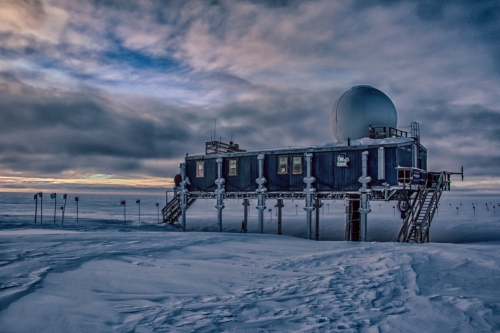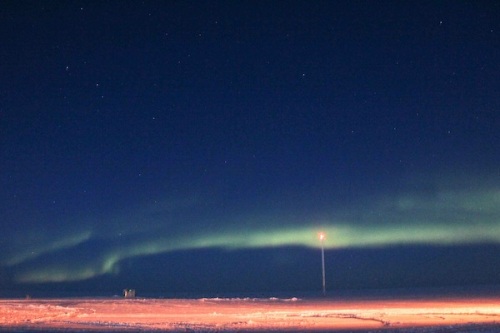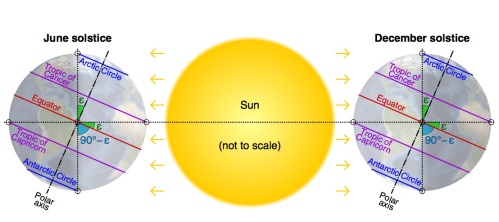
-
Ross Island dominated by Mt. Erebus in the center as seen from out on the ice shelf. McMurdo and Scott Base are located on the dark area to the left.
The weather in Antarctica is notoriously capricious, especially in the stormy West Antarctic, and its storms are legendary. Teams heading out to the “Deep Field” are brought into McMurdo several weeks in advance to complete training and preparations for the field, but also to give a buffer for deployment to field sites. Weather delays of a week, or two, or three are not uncommon especially when combined with ageing aircraft and shifting priorities with many groups needing to utilize flights. Once field preparations are complete we volunteer with other departments and projects and take advantage of the hikes and activities offered around the main USAP hub of operations. It can be frustrating at times to have clearly defined projects and goals and not be able to start. On the other hand most deep field camps are on the bright flat white so the majestic mountain views, hiking trails, and wildlife are savored while amenities like hot showers and warm dark rooms are appreciated. I wrote a post about McMurdo back in 2012 – not too much has changed : ) Check it out here: antarcticarctic.wordpress.com/mcmurdo-station-aka-mac-town and another here: antarcticarctic.wordpress.com/2014/11/10
CRREL: This year I’ve spent a fair bit of time assisting some friends with the Cold Regions Research and Engineer Laboratory (CRREL) as they conduct ground penetrating radar (GPR) and GPS surveys of the McMurdo area. One project is looking at the structure of the McMurdo ice shelf. With the airfields and runways built out on the flat ice it is an integral part of USAP logistics and would pose a huge problem should a large piece calve away unexpectedly. To do the survey we towed 200MHz and 400MHz GPR devices behind snowmobiles along predetermined transects using a precision Trimble GPS unit to record location and elevation. Ice cores were manually collected to determining the depth of the brine layer – essentially the ice depth at specific points. The cores ranged from 5-16 meters deep!
The sea ice, which may break up during the summer, is roughly 1-7m thick, while the ice shelf which remains frozen year-round reached depths of greater than 40m!
Another project was examining the geology and bedrock structure of the McMurdo area in town. While there are still significant patches of ice and snow it’s starting to melt out and most of the roads are clear by now. We made an amusing sight: one person in the lead with a rope around their waist dragging a bright pink plastic sled loaded with a big orange box along the gritty uneven rock roads and hillsides…the other person walking next to the sled wearing a yellow backpack with a big antenna sticking out the top.
SPOT: The South Pole Traverse is heading out around this time of year too so there is a lot to do to help them get cleaned up and on the ‘road’ to Pole. I spent several days helping the SPOT teams reorganizing drums and securing cargo to their sleds. While their set-up is much larger and more complicated than ours will be, the theory is all the same and it was good to re-familiarize myself with the Cat Challengers, though the ones we will be using at WAIS are far older and a bit smaller. See my previous post for more information on SPOT: Antarcticarctic.wordpress.com/spot
Dive Tending: One morning I got to assist the Divers. On that particular day they were recording water column visibility along a steep drop-off not far from the station. We met in town and loaded up a Pisten Bully with all their gear and supplies. Out on the ice we stopped at one of the “Fish Huts.” Small brightly colored buildings, the heated huts sit over maintained holes in the ice at designated dive points. Bundled up in long underwear, a full insulated down suit, and a sturdy dry-suit the two divers were uncomfortably warm while we got everything ready. Gear was brought inside the hut and a line was tied off to the hut wall and then lowered into the water with strobes, flags, and an emergency air tank. In the dim light under the ice and with very limited places to surface it is imperative not to lose the dive hole! Then sitting at the edge of the hole, with practiced efficiency, they pulled on their hoods and masks, strapped on their weights and flippers, locked on their thick lobster-claw mittens, and hoisted on their air tanks and regulators…and then they slipped into the hole!
McMurdo_Sound#Life_below_the_ice
With a burst of bubbles they sank down the 3-4ft hole through the sea ice and disappeared into the dark water. Once they were gone I lowered the ladder and closed the shutters of the hut. The sunlight filtering through made the ice glow an electric blue around the black water. The dive lasted about 20 or 30 minutes as I watched from above noting feathers, or platelets, of ice growing on the surface of the ~28F water and keeping an eye out for the divers as they swam under the hole.

The second diver about to enter the water
Before I knew it there was a mass of bubbles and one of the divers appeared in the hole. I assisted with hauling out their heavy air tanks so they could climb the ladder and warm up next to the stove. Then it was back to town in time for lunch!

Pressure Ridge: An interesting feature in the McMurdo area is the pressure ridge. An area of ice that’s been forced together by ice flow and tidal movement it forms each year right in front of New Zealand’s Scott Base. With unrelenting pressure the ice is driven into the air cracking and breaking to form stunning features – the snow bright white and the ice glowing a deep blue. With so much relative ice movement thin spot and air holes form making it very popular with the Weddell seals in the area.
A friend’s website with some amazing photography of pressure ridges and more can be found here: www.benadkisonphotography.com/antarctica
Ob Tube: The Observation Tube (aka Ob Tube) offers a unique glimpse under the sea ice just in front of McMurdo. A tube, anchored to the ice surface, houses a ladder down 10ft or so to the base where there is a small round area with windows. Not for the claustrophobic, it is a tight fit and is quite dark. Some light filters through the ice to illuminate sea stars on the ocean floor while tiny fish, jelly fish, and pteropod “Sea Angels” float past the thick ice rimmed windows. Perhaps most notable is the texture of the sea ice base. While the top of the sea ice is a varied terrain of snow, blue ice scoured clear, or area of melt later in the summer, the base is comprised of delicate sheets and leaves of ice called platelet ice. The seawater is below freezing here at ~28-29F on average and as the fresh water freezes a salty shimmering brine solution is formed just below the ice level.
Later in the summer the ice will thin and possibly break up here so the Ob tube is a temporary feature only deployed for a few weeks in November.
Check out this post from a fellow polie about the Ob Tube here: http://davidpablocohn.com/ob-tube
Arrival Heights: Arrival Heights is an area just Northeast of McMurdo Station proper, not far from the Castle Rock hiking loop trail. It is an area reserved for clean air sampling and radio and light sensitive experiments – a bit like Summit’s Clean Air Sector and South Pole Dark Sector combined. Several special camera suites study auroras so in the winter the use of lights is kept to a strict minimum. Other experiments are looking at the ionosphere and magnetosphere (space weather) utilizing huge antenna arrays which are highly sensitive to radio transmissions.
As an Antarctic Specially Protected Area (ASPA) it is off limits to the public at large, however occasional guests are permitted as long as they are accompanied by official personnel and traffic, either by foot or vehicle, is limited to designated routes only.
Exposed to some brutal winds it also offers one of the most beautiful views with the Royal Society Mountain Range clearly visible to the West and unhindered views North towards Cape Evans and the sea ice edge.
Cape Evans:
About 20km North of McMurdo Station on Ross Island is Cape Evans. Named for Robert Falcon Scott’s second-in-command Lieutenant Edward Evans it was the staging point for the British Terra Nova Expedition of 1910-1913 .
The expedition’s hut, now dubbed Scott’s Hut, was prefabricated in England and reconstructed on Cape Evans in 1911. It was built to house the 25 men of the expedition during the following winter while they prepared for the journey inland. With lessons learned from Scott’s previous, and frigid, Discovery Hut (located on Hut Point, just a short walk from McMurdo Station and used by Scott during the 1901-04 Discovery Expedition) the 1911 Cape Evans hut contains two stoves, better insulation, and is surrounded on some sides by a covered stable and storage area. Some of the men reported that it was “warm to the point of being uncomfortable.”
In the austral spring of 1911 Scott and several of his men set out to be the first men to reach the South Pole. For more information on that check out this fantastic 2011 article Race to the South Pole by the National Geographic. They arrived on January 17, 1912 to find a tent and a note from Roald Amundsen who had reached the South Pole first on December 14, 1911. Their dreams dashed, they headed towards the coast, however suffering from malnutrition and cold injuries there were no survivors.
This is of particular historic significance as it was this brutal expedition that arrived at the South Pole (just behind Norwegian Roald Amundsen) and from which Scott never returned. Several men remained at Scott’s Hut for the winter of 1912 to search for Scott’s party, however in 1913 they left Antarctica as well, leaving Scott Hut stocked with supplies.
The Hut was used again in 1915-17 by 10 men from Ernest Shackleton’s Ross Sea party after their ship, the Aurora, with the rest of the crew, broke adrift and was taken North in the ice in May 1915. The Ross Sea party was the counterpart to Shackleton’s 1914-17 Imperial Trans-Antarctic Expedition expedition, the ill-fated attempt to cross the continent. They were responsible for laying supply depots for Shackleton’s return from the Pole, however Shackleton trapped in the ice aboard the Endurance, failed to ever reach the continent itself and so the entire effort was for naught.
Due to sub-freezing temperatures, low humidity, and conservation efforts by the US and New Zealand and the Antarctic Heritage Trust both Scott’s Hut and Discovery Hut have remained much as they were left in the early 20th century; Beds are made with shoes tucked beneath, a desiccated and partially dissected penguin lies on a table, glass vials of medicine and solutions line shelves while the kitchen is well stocked with tins and cartons of various food stuffs. A massive pile of seal meat is stacked out in the covered storage area, fairly well preserved for being over a hundred years old, though smelling a bit rancid…The entire site is full of amazing artifacts from the expedition such as snowshoes for their ponies, and cartoons tacked to the wall.
Check out Amusing Planet’s page on Scott’s Hut for more information on the hut’s artifacts and the expedition in general: www.amusingplanet.com/captain-robert-scotts-hut-in-antarctica.html




















































































